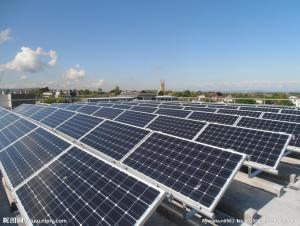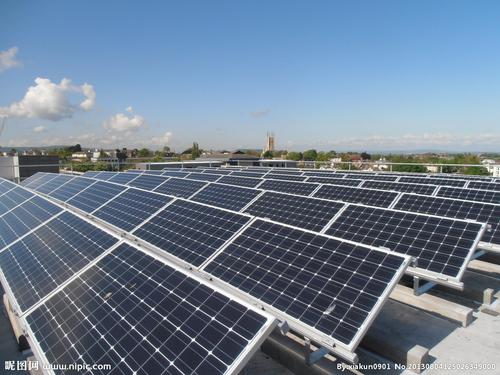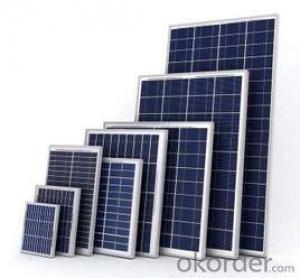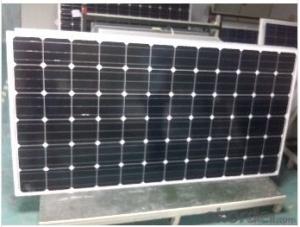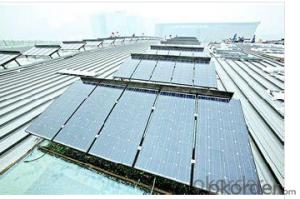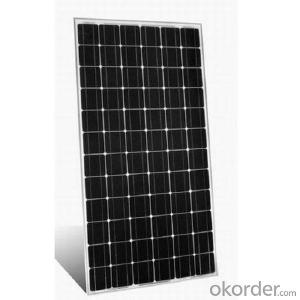Solar Module8 - Solar Panels Washington Township
- Loading Port:
- China Main Port
- Payment Terms:
- TT OR LC
- Min Order Qty:
- -
- Supply Capability:
- -
OKorder Service Pledge
OKorder Financial Service
You Might Also Like
Solar Module
ABOUT YINGLI GREEN ENERGY
Yingli Green Energy Holding Company Limited (NYSE: YGE) is one of
the world’s largest fully vertically integrated PV manufacturers, which
markets its products under the brand “Yingli Solar“. With over 7.0GW
of modules installed globally, we are a leading solar energy company
built upon proven product reliability and sustainable performance. We
are the fi rst renewable energy company and the fi rst Chinese company
to sponsor the FIFA World CupTM.
PERFORMANCE
- High effi ciency, multicrystalline silicon solar cells with high transmission
and textured glass deliver a module effi ciency of up to 16.0%,
minimizing installation costs and maximizing the kWh output of your
system per unit area.
- Tight positive power tolerance of 0W to +5W ensures you receive
modules at or above nameplate power and contributes to minimizing
module mismatch losses leading to improved system yield.
- Top ranking in the “TÜV Rheinland Energy Yield Test” and the
“PHOTON Test” demonstrates high performance and annual energy
production.
RELIABILITY
- Tests by independent laboratories prove that Yingli Solar modules:
Fully conform to certifi cation and regulatory standards.
Withstand wind loads of up to 2.4kPa and snow loads of up to
5.4kPa, confi rming mechanical stability.
Successfully endure ammonia and salt-mist exposure at the highest
severity level, ensuring their performance in adverse conditions.
- Manufacturing facility certifi ed by TÜV Rheinland to ISO 9001:2008,
ISO 14001:2004 and BS OHSAS 18001:2007.
WARRANTIES
- 10-year limited product warranty1.
- Limited power warranty1: 10 years at 91.2% of the minimal rated power
output, 25 years at 80.7% of the minimal rated power output.
1In compliance with our Warranty Terms and Conditions.
QUALIFICATIONS & CERTIFICATES
IEC 61215, IEC 61730, MCS, CE, ISO 9001:2008, ISO 14001:2004, BS OHSAS
18001:2007, PV Cycle, SA 8000
ELECTRICAL PERFORMANCE
Electrical parameters at Standard Test Conditions (STC)
Module type YLxxxP-29b (xxx=Pmax)
Power output Pmax W 260 255 250 245 240
Power output tolerances ΔPmax W 0 / + 5
Module effi ciency ηm % 16.0 15.7 15.4 15.1 14.8
Voltage at Pmax Vmpp V 30.3 30.0 29.8 29.6 29.3
Current at Pmax Impp A 8.59 8.49 8.39 8.28 8.18
Open-circuit voltage Voc V 37.7 37.7 37.6 37.5 37.5
Short-circuit current Isc A 9.09 9.01 8.92 8.83 8.75
Electrical parameters at Nominal Operating Cell Temperature (NOCT)
Power output Pmax W 189.7 186.0 182.4 178.7 175.1
Voltage at Pmax Vmpp V 27.6 27.4 27.2 27.0 26.8
Current at Pmax Impp A 6.87 6.79 6.71 6.62 6.54
Open-circuit voltage Voc V 34.8 34.8 34.7 34.6 34.6
Short-circuit current Isc A 7.35 7.28 7.21 7.14 7.07
STC: 1000W/m2 irradiance, 25°C cell temperature, AM1.5g spectrum according to EN 60904-3.
Average relative effi ciency reduction of 3.3% at 200W/m2 according to EN 60904-1.
NOCT: open-circuit module operation temperature at 800W/m2 irradiance, 20°C ambient temperature, 1m/s wind speed.
OPERATING CONDITIONS
Max. system voltage 1000VDC
Max. series fuse rating 15A
Limiting reverse current 15A
Operating temperature range -40°C to 85°C
Max. static load, front (e.g., snow) 5400Pa
Max. static load, back (e.g., wind) 2400Pa
Max. hailstone impact (diameter / velocity) 25mm / 23m/s
CONSTRUCTION MATERIALS
Front cover (material / thickness) low-iron tempered glass / 3.2mm
Cell (quantity / material / dimensions /
number of busbars)
60 / multicrystalline silicon / 156mm x 156mm / 2 or 3
Encapsulant (material) ethylene vinyl acetate (EVA)
Frame (material / color / anodization color /
edge sealing) anodized aluminum alloy / silver / clear / silicone or tape
Junction box (protection degree) ≥ IP65
Cable (length / cross-sectional area) 1000mm / 4mm2
Plug connector
(type / protection degree) MC4 / IP67 or YT08-1 / IP67 or Amphenol H4 / IP68
PACKAGING SPECIFICATIONS
Number of modules per pallet 29
Number of pallets per 40' container 28
Packaging box dimensions
(L / W / H) 1700mm / 1135mm / 1165mm
Box weight 568kg
Unit: mm
• Due to continuous innovation, research and product improvement, the specifi cations in this product information sheet are subject to change
without prior notice. The specifi cations may deviate slightly and are not guaranteed.
• The data do not refer to a single module and they are not part of the offer, they only serve for comparison to different module types
- Q: how fast does a 25watt solar panel generate power to a battery? trying to figure out a conversion factor here to get a rough estimate of how many i would need to power my house, please help?
- To figure our how many you need, take a look at your power bill. It will tell you how many kilowatt/hours you used during the month. My bill says I use about 2000 kilowatt/hours per month, or about 2000 kwh /30 days=67 kw/h hours per day. That is 67,000 watt hours. To supply that with solar panels, you have to generate at least 67,000 watt hours, but you don't have a full day to do it, since you have to do it while the sun is up. So you put the energy into batteries during the day, so you can use it at night. A 25 watt panel generates about 25 watts when fully illuminated by the sun. If you fully illuminate it for an hour, you get 25 watt hours. If you get 2 hours of sunlight a day, that would seem to imply that I need 67000 watt hours/25 watts /2 hours=45 panels. But for most of the day, the sun isn't hitting the panel fully, so it isn't going to generate the full 25 watts. When the sun is 45 degrees to the side, you only get about 70%. When the sun is 60 deg to the side, you only get 50%. And what do you do on cloudy days? And the shorter days in the winter? To make up for this, you have to increase the number of panels to make up for the loss. So in reality, I might need double this number of panels, for realiable solar power throughout the year. That works out to about 90 panels, or ,250 watts worth for my house.
- Q: I don't have a regulator connected as they are a little expensive for a pensioner, If I join the panels into line to the battery bank from the roof should that be OK.?
- Two things on a regulator: a) It will optimize the charge to the batteries - and thereby distribute the most possible power to your active circuits during the day. b) It will prevent the power from the panels from boiling (no kidding) the batteries - no small thing as they are the second largest investment you have after the panels themselves. This is much more critical if you have sealed or Zero-Maintenance batteries. I strongly suggest that you get a regulator as it will significantly lengthen battery life. Follow the directions on the regulator for optimum input voltage and it will let you know whether all the panels should be in series, parallel or series/parallel. But cutting to the chase, you can certainly gang up panels as needed.
- Q: Do solar panels require regular maintenance?
- Yes, solar panels generally require regular maintenance to ensure optimal performance and longevity. This includes periodic cleaning to remove dirt, debris, and snow, as well as checking for any possible damage or malfunctioning components. Additionally, regular inspections and maintenance by professionals are recommended to identify and address any potential issues or inefficiencies.
- Q: i was told that by making a solar panel they cause more pollution than they will end up getting rid of. Is that true?
- It depends on what type of pollution you are talking about. Some of the newer cells that don't use silicone are made with dangerous chemicals that are just dumped into the local water supply when made in China or other places with no real environmental controls. No matter how much carbon free energy the cells produce they will never clean up the mess people made when building them.
- Q: Can solar panels be installed on remote or off-grid locations?
- Yes, solar panels can be installed on remote or off-grid locations. In fact, they are highly suitable for such areas as they do not rely on a traditional power grid for electricity generation. By harnessing sunlight, solar panels can provide a reliable and sustainable source of power even in remote locations where connecting to the grid may not be feasible or cost-effective.
- Q: How do solar panels impact the local economy?
- Solar panels can have a positive impact on the local economy in several ways. Firstly, the installation and maintenance of solar panels create jobs, boosting employment opportunities in the area. Additionally, the use of solar energy reduces dependency on traditional energy sources, which can lead to lower energy costs for businesses and residents, freeing up more money to be spent locally. Furthermore, solar panel installations often require local partnerships and suppliers, supporting local businesses and stimulating economic growth. Ultimately, the adoption of solar panels contributes to a more sustainable and resilient local economy.
- Q: Hoping to find instruction, materials list and hardware needed to construct solar panels myself, how many and make it happen instead of talking about it
- Silica based solar cells are not the kind of thing you whomp up in you basement. Here are a couple ideas for solar systems you can build and install yourself. Take a 4 x 8 sheet of /2 inch plywood. Frame sides with 2 x 4's. Screw tin cans in a staggered row (checker board) pattern inside frame. The more cans the more heat you get so place them nearly touching. Paint cans and entire assembly flat black. Cover top with glass, plexiglass (best) or heavy mill clear plastic (cheapest)Place on roof. Drill 3-4 inch holes in opposing sides. Run pipe or tubing into house. Attach to small low speed fan. The black paint will absorb sunlight and heat. The air moving through box will carry heat into house. It's a cheap efficient way to help heat your home. You can vary size and shape of box to fit your roof. If you use more than one box, hook them up in series. More boxes mean more surface area means more heat. To heat water. Take a steel tank. A car gas tank works well. It is galvanized so it won't rust, is cheap, and easily available at any auto salvage yard. But you will have to flush in throughly to remove gasoline odor. A steel 55 gallon drum is easier to work with but may cost more. Paint exterior of tank flat black. Weld/glue/clamp water pipes to tank. Place on ground in area that gets lots of sunlight. Attach water supply to tank and route discharge pipe to house or appliance. Black painted steel absorbs heat from sun light and heats water. In spring and fall you get warm to hot water. In summer you get scalding hot water and in winter you get cold to luke warm water. Both of these solar powered systems are seasonal and their output varies according to location and climate, but they are very inexpensive and easy to build and provide FREE heat and/or hot water for many years with little or no maintainence.
- Q: Can solar panels be used for camping or outdoor activities?
- Yes, solar panels can be used for camping or outdoor activities. Portable solar panels are designed to be lightweight and easily transportable, making them ideal for powering electronic devices and charging batteries in remote locations. They harness the sun's energy to generate electricity, allowing campers to have a reliable and sustainable power source while enjoying the outdoors.
- Q: I can't figure out how to charge a Ni Cd (BD 8V Firestorm) battery directly with a solar panel so I've come up with an alternative which might or might not work. I thought I would connect an inverter (I found a nice 400W for $30) to my trucks battery and plug the BD Firestorm battery charger into the inverter. Then I was thinking I could use a 5W solar panel to trickle charge the truck battery and keep it connected after the Ni Cd is charged to ensure the truck battery is topped off. The truck would not be running during this process. Will this solution work? Is there a better solution?
- Two of those solar panels connected in series will easily charge a 8V battery. I would not even be concerned about over voltage the solar cells will have plenty of internal resistance.
- Q: when building a solar panel should the diode be on the positive or negative sidelittle more detail i just built a solar panel and im running it to a grid tie converter should i put diodes in if i add another panel or are they only for battery systems?
- I'm assuming you're talking about the blocking diode and not the bypass diodes. Positive side.
Send your message to us
Solar Module8 - Solar Panels Washington Township
- Loading Port:
- China Main Port
- Payment Terms:
- TT OR LC
- Min Order Qty:
- -
- Supply Capability:
- -
OKorder Service Pledge
OKorder Financial Service
Similar products
Hot products
Hot Searches
Related keywords
